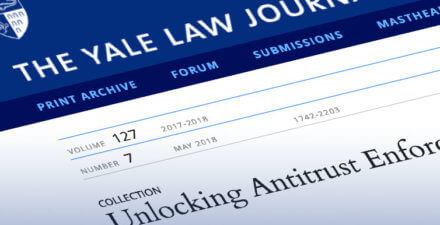Brad DeLong: Worthy reads on equitable growth, February 1–7, 2019
Worthy reads from Equitable Growth:
- Louis Brandeis believed that bigness is bad, “per se,” thus failing to see that, well, at least since 1870, value chains and the division of labor had become sufficiently complicated that efficient production required a great deal of central planning on the level of the large firm. Toyota today sells $250 billion worth of cars each year—that is 0.2 percent of global GDP—and roughly two-thirds of that value flow is under the centrally planned direction of the Toyota design and production management teams, not the result of arms-length market-price deals between truly independent producers. Bork believed that any bigness was good if could be claimed to be the result of some clever economy of scale that a lawyer who was part of the judge’s social circle could think up but was never credible as anything other than an excuse for rent-seeking corruption. To find the true path, look, as Jonathan Baker says, to FDR antitrust guru Thurman Arnold. Read Baker’s recent Competitive Edge column, “Revitalizing U.S. Antitrust Enforcement Is Not Simply a Contest Between Brandeis and Bork—Look First to Thurman Arnold.” Baker writes: “Growing market power in the United States today puts a spotlight on our nation’s antitrust laws—the critical policy tool for restoring competition where it is lacking—from airlines and brewing to hospitals and dominant online platforms. But how can these laws be made more effective in this environment? The best guide from the past is Thurman Arnold, President Franklin D. Roosevelt’s longest-serving antitrust enforcer. Arnold helped shape a political consensus for effective antitrust enforcement. Yet his singular contribution is often overlooked in the present-day debate over antitrust’s future. That achievement—the embrace of an antitrust enforcement playbook for supervising large firms that is competition-promoting and economic growth-enhancing—is endangered today.”
- Watch Heather Boushey at the Peterson Institute forum, “Confronting Inequality: How Societies can Choose Inclusive Growth.” The institute held the event to present the book Confronting Inequality: How Societies can Choose Inclusive Growth by Jonathan Ostry, Prakash Loungani, and Andrew Berg of the International Monetary Fund. The forum also includes PIIE Nonresident Senior Fellow and Equitable Growth Steering Committee member Jason Furman.
- The social safety net alleviates rural poverty. It does not cause it by creating indolence. The then-Whig and now-Republican idea that the rural poor were idle buggers looking for a handout was overwhelmingly false in early 19th century Britain and is false in early 21st century America today. Read James P. Ziliak, “Economic Change and the Social Safety Net: Are Rural Americans Still Behind? Ziliak writes: “The U.S. economy has been rocked by major business cycle and secular shocks that differentially affected the fortunes of urban and rural areas … coinciding with … the dramatic growth and transformation of the social safety net … How the … changes have interacted to at times exacerbate, and other times attenuate, well-being across regions and over time is little studied … The analysis here is descriptive.”
- This puzzles me: At least semi-stable schedules are relatively easy to provide for employers and are worth a lot to workers. I do kind of wonder if these trends are the result of now two decades of slack labor markets in which workers are—and employers want to remind workers that they ought to be—grateful for any jobs at all. Read a column in The Hill by Equitable Growth grantees Daniel Schneider and Kristen Harknett, “For Job Quality, Time Is More than Money,” in which they write: “What we found is striking: Working in the service sector doesn’t only mean low pay and few fringe benefits, it also means turning over the reins to your employer when it comes to when and how much you will work. This so-called just-in-time scheduling approach has consequences for millions of American workers. People with unstable work schedules are markedly less happy. They sleep less well and are more likely to report feeling distressed. This pattern plays out consistently whether we look at short notice, last-minute changes or routine ups and downs in work hours. For instance, employees who worked “on-call” shifts were less likely by half to report good sleep quality than their co-workers who didn’t work on-call.”
- Bespoke subsidies to individual firms plus lack of transparency equals kleptocracy. Read the recent working paper by Nathan M. Jensen and Calvin Thrall, “Who’s afraid of sunlight? Explaining opposition to transparency in economic development,” in which they write: “Why do some firms oppose transparency of government programs? In this paper we explore legal challenges to public records requests for deal-specific, company-specific participation in a state economic development incentive program. By examining applications for participation in a major state economic program, the Texas Enterprise Fund, we find that a company is more likely to challenge a formal public records request if it has renegotiated the terms of the award to reduce its job-creation obligations. We interpret this as companies challenging transparency when they have avoided being penalized for noncompliance by engaging in nonpublic renegotiations. These results provide evidence regarding those conditions that prompt firms to challenge transparency and illustrate some of the limitations of safeguards such as clawbacks (or incentive-recapture provisions) when such reforms aren’t coupled with robust transparency mechanisms.”
Worthy reads not from Equitable Growth:
- Odds are now 50-50 that the entire eurozone is or is about to be in a recession. Read Lucrezia Reichlin, “The Threat of a Eurozone Recession,” in which she writes: “My company, Now-Casting Economics, first detected a slowdown in the eurozone … started in the third quarter of 2017 and has affected all major eurozone economies, particularly Germany and Italy. This runs contrary to the widely held view of the eurozone as comprising a core of successful countries—especially Germany—and a debt-ridden, slow-growth periphery.”
- A very welcome shift from a central bank that two months ago looked hell-bent on a policy likely to cause a recession. What explains the shift, however? I do not understand why the Fed’s policy was what it was two months ago. While I understand their policy now, and while I approve of their shift, I do not understand the why. Read Frances Coppola, “What Is The Real Reason For The Fed’s Sudden Decision To Stop Raising Interest Rates?” Coppola writes: “The Fed has put the brakes on. At its latest monetary policy meeting, the FOMC left interest rates unchanged and said it would be ‘patient’ about further interest rate rises. Furthermore, the FOMC’s forward guidance about the pace of balance sheet reduction says that it is ‘prepared to adjust any of the details for completing balance sheet normalization in light of economic and financial developments, including reversing course and doing more QE if necessary.’ Yet only a month ago, the Fed was signaling two interest rate rises in 2019 and no change in the pace of balance sheet reduction. What has caused this sudden change of heart?”
- The Philips Curve was always properly used as a heuristic framework for thinking about issues, not as a machine for generating certainty-equivalent forecasts to use in month-to-month policy decisions. Read Jeanna Smialek, “R.I.P. Phillips Curve? The Fed’s Wonky Guidestar May Be Dimming.” Smialek writes: “The Fed has been moving from tight labor-brings-inflation logic. They’re now waiting for actual, not anticipated, price gains.”
- The Federal Reserve turns on a dime. I wish that rates were lower as they pursue a higher inflation target than 2 percent a year, but they appear to have decided that they, after all, really do not wish to invert the yield curve. That makes this a brighter day then I had expected. Read Tim Duy, “Setting The Doves Free,” in which he writes: “The statement was more dovish than I anticipated; I did not think they would want to take rate hikes off the table to this degree. I forgot that the Fed often turns their story later than I think they should, but when they turn, they turn quickly … The Fed believes they will maintain a larger than expected balance sheet … The bar for raising rates seems high now and apparently hinges on the inflation boogeyman to finally show his face … This sounds like the rate hike cycle is over—or largely over—as long as the economy eases as expected.”





